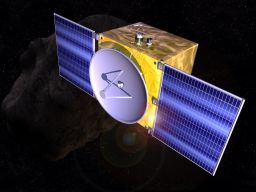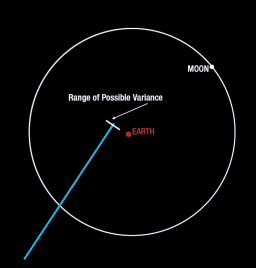Emily Lakdawalla • Feb 27, 2008
Tag it, track it!
So, as I mentioned yesterday, The Planetary Society has awarded $50,000 in prize money to three industry and four student teams who submitted mission proposals to our Apophis Mission Design Competition. This was a really fun project to work on. The premise of the competition was the following: suppose our near-Earth asteroid surveys discover a largish (few-hundred-meter-diameter) asteroid that will be making a very close approach to Earth in the future, and that telescope-based tracking of the asteroid is not precise enough to eliminate the possibility of a future impact. In order to get better information on the orbit (and impact probability) of such a body, we will have to rapidly develop and launch a spacecraft that will rendezvous with the asteroid and permit us to track it more precisely. Odds are that such a tracking mission will improve our understanding of the asteroid's path enough that we will be able to eliminate the possibility of a future impact, and we can all relax. But it could show us that an impact is inevitable unless we do something to deflect the asteroid from its path. What would such a mission look like? The Apophis Mission Design Competition was intended to stimulate the development of scenarios for such a tagging mission.
You can read the complete competition scenario here. We asked proposers for a lot of details. They needed to supply a full mission design. This included an outline of the design and instrumentation of the spacecraft and its systems, breakdown of mass and power requirements, identification of launch vehicle and trajectory, approximate cost estimates, and more. They needed to explain their tracking method and show how it would sufficiently reduce the uncertainty in Apophis' future path. And they had to show that such a mission could be built, launched, and flown to Apophis, and data returned, in time for us to decide by 2017 whether a deflection mission would be necessary (which would allow three years to develop the deflection mission and nine years to rendezvous with and deflect the asteroid from its dangerous path).
We asked people to send us notices of intent first, and we received more than 100 such letters from 25 different countries. In the end, we received 37 proposals, with the proposers representing 20 different countries on 6 continents (we'll have to try to drum up some interest from Antarctica next time). We were delighted to see such international interest -- after all, an asteroid would respect no national borders, and the possibility of an Earth impact is a truly global problem.
The first judging step involved a few people here at the Society going through all of the proposals and just making sure they'd met the requirements, without passing any judgment at all on the quality of the proposed mission. I was one of the people tasked with this job, which meant I got to read all the proposals. There was a huge amount of creativity applied to the mission scenario, which made that job fun. But I also did a lot of tsk-tsk-tsking at people who didn't seem to have read the competition rules. Some people proposed deflection missions, not tracking missions. Others lacked important sections, like analysis -- with math and stuff -- of how their proposed mission would give us the data we need to determine Apophis' future path. In general, people who submitted proposals as individuals fared much worse than teams, which was no surprise; designing a mission requires expertise in so many different areas that it seems you have to draw upon multiple people's knowledge to come up with a solid plan. And it probably helps a lot to have someone else to bounce ideas off of.
The other thing I noticed was that among the proposers who did meet all the requirements, a great many couldn't seem to help themselves from designing full-on science missions to study Apophis. All we asked for was tracking information. Yet the proposers, particularly (I was amused to note) the industry groups, came back with complex, expensive spacecraft with as many as six science instruments -- more than any of the previous missions sent to do science at an asteroid or comet, except for ESA's flagship mission Rosetta. The proposers did make a good case that at least some scientific study of the asteroid was a necessity. If the asteroid has complicated albedo patterns on its surface -- light patches here and dark patches there -- those patterns can have important ramifications for how the asteroid absorbs and reradiates sunlight, which directly influences its spin and even its orbital path through the complicated effects known collectively by the acronym YORP. Other proposals had spacecraft plus one or several instrumented probes or landers, which multiplies the complexity of your system, makes for additional communications requirements, etc. Having lots of instruments or extra probes means you need a lot of power and a lot of mass and therefore a big, expensive launch vehicle. It didn't seem to me that this is what the competition was seeking. But that wasn't for me to say; all these proposals met the basic requirements, so they got forwarded on to the review panel (without any editorial comment from me, I should add).

SpaceWorks / SpaceDev for The Planetary Society's Apophis Mission Design Competition
Foresight
Foresight, the winning entry in The Planetary Society's Apophis Mission Design Competition, is a small, low-cost spacecraft. The bus measures 85 by 85 by 70 centimeters. In this artist's conception, the bulk of Apophis lies in the background. Foresight would orbit Apophis for a month, characterizing its surface with a camera and laser range finder, then leave orbit and fly in formation with Apophis around the Sun, at a distance of 2 kilometers, during the tracking phase of the mission.I hadn't ever heard of either of the companies involved in the winning proposal, SpaceWorks and SpaceDev. Speaking to the SpaceWorks representatives who came to our press conference yesterday, I was amused to find that the lean mission was proposed by a lean company, with only 13 employees (they don't even have a secretary). Maybe that's what it takes to keep spacecraft small and simple.
The review panel considered all the proposals in one pool, and found that none of the teams of students who proposed missions met the standard set by the industry groups. But, based on the comments made by the review panel members, it seems like they were much more excited by the student proposals than by the more thorough (and more realistic) industry proposals. I think more than one of the panelists would like to run out and hire the students involved in the proposals as soon as they finish their degrees. Naomi Murdoch, of ESA's Advanced Concepts Team, remarked "the innovative thinking and creativity demonstrated by some of the teams, especially the students, is particularly inspiring and promising given these are potentially the future minds of the space industry!" My personal favorite among the students was also the one selected for the first student prize, Pharos. I loved the idea of having four small probes with accelerometers and temperature sensors, which would be sent to impact the asteroid one at a time. After the first probe was in place, the impact of each subsequent probe would be picked up by the accelerometers on the previous ones, allowing a crude seismic survey of the asteroid's interior. Now, Hayabusa demonstrated how fiendishly difficult it is to actually land a tiny probe onto the surface of an asteroid; but the Pharos probes would provide an unprecedented data set if they worked. And accelerometers and temperature sensors are really very simple; it doesn't seem unrealistic to me to propose little ballistic impactors with such instruments and a little radio transmitter just strong enough to communicate with the mother ship, in orbit just a couple of kilometers away.
Where do the winners go from here? We promised to share the winning proposals with appropriate representatives of the world's space agencies. In fact, we've effectively already done that; among the members of the review panel were folks like Pete Worden, head of NASA's Ames Research Center. We'll also continue to work to raise public awareness of the impact hazard, and the fact that while impacts represent the greatest threat to human civilization, we now have the expertise necessary to predict when and where they will happen. With one or two missions, we can even develop the expertise necessary to prevent an impact from happening, using currently available technology. We can't do that for earthquakes or volcanoes or hurricanes; even climate change may, for political reasons, be unpreventable. But we could probably prevent an impact, and we should make sure we're prepared to do it!
Support our core enterprises
Your support powers our mission to explore worlds, find life, and defend Earth. You make all the difference when you make a gift. Give today!
Donate

 Explore Worlds
Explore Worlds Find Life
Find Life Defend Earth
Defend Earth


